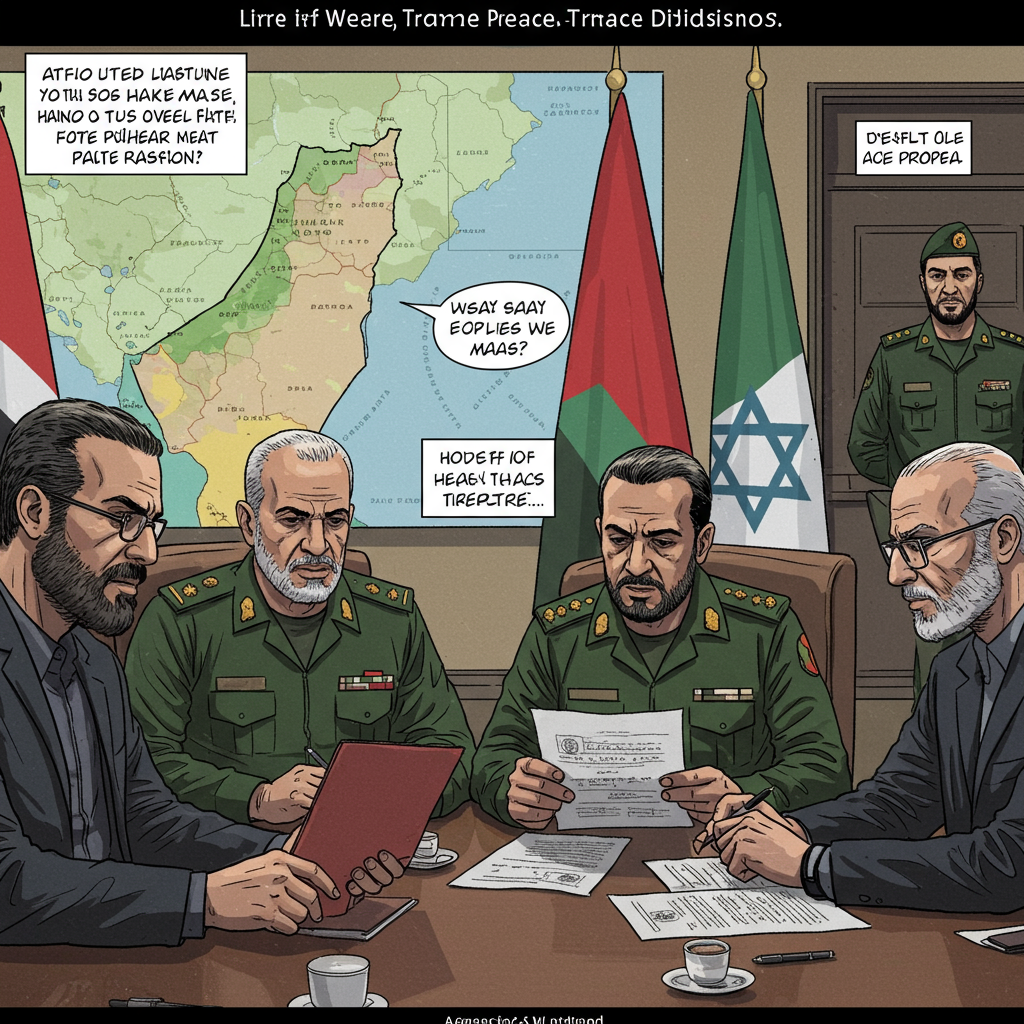A contentious peace proposal, presented as a blueprint for ending the Gaza conflict, puts Hamas in an extraordinary position. This US-Israeli drafted plan, seemingly skewed against Palestinian interests, paradoxically offers Hamas a compelling pathway forward. Far from a straightforward rejection, the group’s leadership faces immense pressure and strategic incentives to accept, perhaps with critical amendments. Understanding this complex calculus reveals a potential geopolitical pivot point for the region, where a seemingly unfavorable agreement might unlock Hamas’s long-term political ambitions in the West Bank.
Unveiling the US-Israeli Peace Proposal for Gaza
President Donald Trump’s comprehensive 20-point plan for stabilizing Gaza appears to be less a negotiation and more a joint US-Israeli mandate. This framework, developed without genuine Palestinian input, crosses multiple long-standing red lines for Hamas. Most provisions favoring Israel, apart from mutual prisoner exchanges, hinge on that nation’s discretion. The proposal even suggests long-term Western oversight of Gaza, potentially spanning many years, with minimal input from Palestinians themselves. Despite these deeply problematic elements, the likelihood of Hamas eventually signing on, possibly with specific clarifications, remains surprisingly high.
A “Diktat” or a Path to Stability?
The core text of the US-Israeli proposal raises significant concerns for Palestinians. It offers only a vague acknowledgment of Palestinian statehood as an “aspiration,” suggesting merely a “dialogue” about future “peaceful and prosperous coexistence.” This contrasts sharply with the demands of key Gulf Arab countries, like the United Arab Emirates and Saudi Arabia, who view a clear framework for establishing a Palestinian state as indispensable for any lasting peace. The current Israeli government’s voiced determination to annex significant portions of the occupied West Bank further complicates this already tenuous promise, offering little reassurance of citizenship for over two million stateless Palestinians.
Israel’s Calculus: Pressure and Accomplished Aims
Prime Minister Benjamin Netanyahu’s endorsement of the Trump plan stems from his own set of intense pressures. His military is overstretched, the Israeli public demands the return of hostages, and his Washington ally seeks an end to the protracted conflict. At a joint press conference with Trump, Netanyahu hailed the proposal, declaring it “meets all of our war aims.” Indeed, many of Israel’s military objectives on the ground have already been largely achieved. Hamas’s governmental infrastructure, Gaza’s leadership, and any clear command and control have been severely degraded, literally reduced to rubble.
Netanyahu’s Geopolitical Leverage
The proposal provides Netanyahu with a convenient path to address domestic and international concerns. By presenting a plan that seemingly fulfills Israel’s security requirements and outlines a potential path to peace, he can alleviate pressure while consolidating perceived military victories. The humanitarian components, aimed at alleviating the severe suffering in Gaza, also offer a facade of constructive engagement, despite the plan’s heavily one-sided nature.
Hamas’s Strategic Crossroads: From Insurgency to Political Future
Hamas faces a profoundly intricate strategic equation. While its formal political structure in Gaza may be shattered, the group has successfully mounted a resilient insurgency. Small, adaptable cells of fighters continue to operate, often repurposing unexploded Israeli ordnance into improvised explosive devices. Historical precedents, from Afghanistan to Iraq, demonstrate that well-organized insurgencies can indeed wear down conventional armies over extended periods. Yet, Hamas’s ultimate ambition might not be an endless conflict within a ruined Gaza Strip. The US-Israeli proposal, despite its numerous “poison pills,” could offer both immediate relief to war-ravaged Palestinians and a crucial opportunity for Hamas to re-emerge as a significant political force, particularly in the West Bank.
Core Palestinian Concerns: Statehood and Self-Determination
The plan fundamentally disregards the legitimate concerns of Palestinians, whose representatives were completely excluded from its formulation. A core demand for an independent Palestinian state, though primarily a project of the secular Fatah party, resonates deeply with most Palestinians. Had this proposal explicitly committed Israel to acknowledging Palestinian statehood, or even hinted strongly in that direction, Hamas might have claimed a monumental national achievement after a war costing over 60,000 Palestinian lives. However, the current text offers no such reassurance for Palestinians living under occupation regarding future state citizenship.
Disarmament and Enduring Military Presence
Beyond statehood, the proposal’s insistence on Hamas’s full disarmament presents another major hurdle. It also stipulates an indefinite, substantial Israeli military presence across a significant portion of Gaza. Traditionally, these terms would be non-negotiable for Hamas, which has consistently refused to disarm, even while expressing openness to stepping back from direct governance in favor of an alternative Palestinian civic administration. Hamas has also demanded Israel’s complete withdrawal from Gaza as a precondition for peace.
Echoes of Colonialism: Resentment Over External Control
Adding to Palestinian apprehension, the agreement carries a distinct colonial overtone that deeply offends many. It envisions Gaza falling under the control of a committee led by Donald Trump, with executive authority potentially vested in former British Prime Minister Tony Blair. Many Palestinians view British colonial rule as the historical precursor to the creation of Israel and the suppression of their own independence claims. The United States, since 1967, has been seen as Israel’s indispensable backer and protector. Therefore, the prospect of British and American control over Gaza naturally evokes profound suspicion and historical resentment among the populace.
Weighing the Benefits: Humanitarian Aid and Reconstruction for Gaza
Despite its numerous clashes with Hamas’s stated interests and Palestinian national sentiments, the proposal offers significant promises that cannot be easily ignored. Under its terms, ordinary Palestinians would receive protection from displacement. On paper, at least, the plan outlines a vision for Gaza’s bright future, promising large-scale international investment and extensive reconstruction efforts. This could mark an end not just to the acute suffering from the current war, but also to the pervasive misery that has plagued the Strip since 2007. That year, Israel and Egypt imposed a debilitating blockade following Hamas’s violent takeover of the territory.
Regional Influence: Pushing for Peace in the Middle East
The humanitarian prospects outlined in the proposal will likely generate immense pressure on Hamas from various segments of Palestinian society, both within Gaza and globally, to accept the agreement and bring the war to an end. Furthermore, Hamas’s key international sponsors, Turkey and Qatar, have already signaled their welcome for this initiative. Alongside regional players such as Egypt, Jordan, and other Gulf Arab countries, these nations are also expected to actively encourage Hamas towards acceptance.
Hamas’s Long Game: Ascending in the West Bank Political Arena
Ultimately, Hamas may possess compelling strategic reasons to embrace the deal. Relinquishing its direct governance in Gaza could allow the group to redirect its resources and focus on long-term efforts to expand its presence, influence, and political leverage within the West Bank. The true centers of power within the Palestinian national movement reside in Ramallah and East Jerusalem. There, Hamas’s secular nationalist rivals, Fatah, firmly control the Palestinian Authority, which governs self-controlled areas in the West Bank. Fatah also dominates the Palestine Liberation Organization (PLO), the internationally recognized voice for Palestinians. The PLO’s international standing has recently strengthened through diplomatic recognition of Palestinian statehood by several Western nations, including Britain, France, Australia, Canada, and Portugal – a significant diplomatic achievement.
Infiltrating the PLO and Challenging Fatah
Hamas’s foundational goal has always been to wrest control of the Palestinian national movement from its secular adversaries and redefine it as an Islamist cause. This ambition can only be realized by successfully infiltrating and ultimately taking over the PLO, a feat Hamas has never managed. Governing an isolated, devastated, and besieged Gaza Strip will not bring Hamas closer to this objective. However, by accepting the current peace proposal, Hamas could potentially free itself to cultivate a robust political presence in the West Bank, thereby positioning itself to challenge Fatah and advance its overarching strategic goals.
The “Yes, But” Scenario: A Strategic Move by Hamas
Given the seemingly unacceptable nature of many provisions in this 20-point ultimatum, Prime Minister Netanyahu might actually be banking on Hamas’s outright rejection. Such a refusal would potentially unleash him to “finish the job” in Gaza, as Trump suggests, whatever that might imply. A simple “no” from Hamas remains a distinct possibility.
However, Hamas could strategically maneuver itself into a stronger position by saying “yes”—or, more plausibly, “yes, but.” This conditional acceptance would involve demanding greater clarity and negotiation on the vague points within the current plan. Whether Hamas chooses this nuanced approach will likely depend on the political leadership, predominantly based in Turkey and Qatar, being able to exert influence over its fighters operating on the ground. Should Hamas respond with a “yes, but,” regional leaders would likely express considerable relief, potentially viewing it as a sign of the group becoming more pragmatic. The Trump administration might also be inclined to engage with such a conditional acceptance. Therefore, despite the plan’s apparent unsuitability for the Palestinian group, a conditional assent from Hamas is entirely plausible.
Frequently Asked Questions
What are the critical “red lines” for Hamas in the US-Israeli peace proposal?
The US-Israeli peace proposal contains several non-negotiable points for Hamas and many Palestinians. Key among these are the demands for Hamas’s full disarmament and the stipulation of an indefinite, large Israeli military presence in Gaza. Additionally, the plan’s vague allusion to Palestinian statehood as merely an “aspiration,” rather than a concrete commitment, and its suggestions for Western control over Gaza, evoke strong opposition due to historical concerns about sovereignty and self-determination.
Which international and regional entities are pressuring Hamas to accept the peace agreement?
Hamas is experiencing considerable pressure from multiple international and regional actors to accept the peace agreement. Its remaining key international sponsors, Turkey and Qatar, have both welcomed the initiative and are likely to push for acceptance. Furthermore, regional powers like Egypt, Jordan, and the Gulf Arab countries are also expected to exert influence, driven by concerns for regional stability and the humanitarian situation in Gaza. Within Palestine, the widespread desire among ordinary Palestinians for an end to the war and famine creates immense internal pressure on Hamas.
How could accepting the Gaza peace plan empower Hamas to advance its political influence in the West Bank?
Accepting the Gaza peace plan, despite its drawbacks, could be a strategic pivot for Hamas. By relinquishing its direct, besieged control over Gaza, Hamas could redirect its resources and focus on cultivating a stronger political presence and influence in the West Bank. The true centers of Palestinian national movement power reside there, particularly in Ramallah and East Jerusalem, where Fatah currently holds sway over the Palestinian Authority and the PLO. A strategic shift to the West Bank could allow Hamas to infiltrate the PLO, challenging Fatah’s dominance and advancing its long-term goal of transforming the Palestinian national movement into an Islamist cause.




